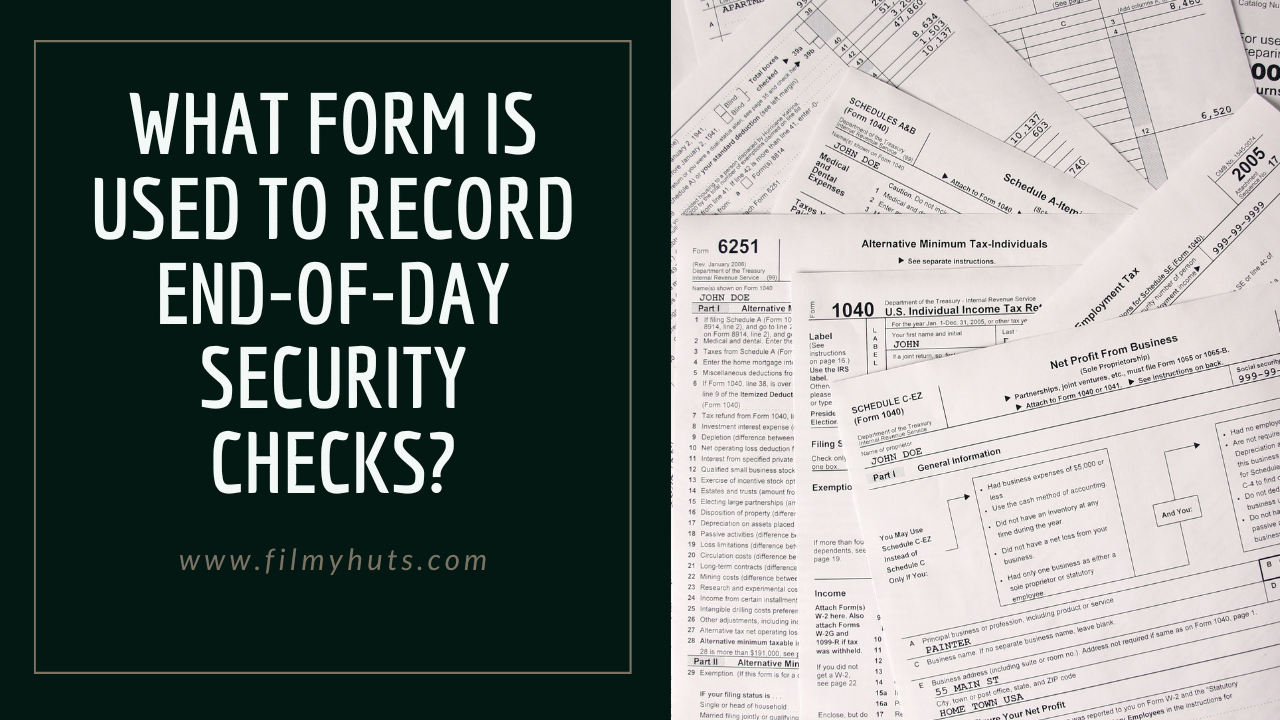In today’s world, the importance of security cannot be overstated. Be it a residential complex, a commercial establishment, or an industrial facility, security checks form a crucial part of daily operations. Specifically, end-of-day security checks stand as the final guardrail, ensuring all’s well before everyone goes home for the night. But, how does one record these checks? Enter the end-of-day security check form – a tool designed to enhance safety, boost accountability, and maximize efficiency. Let’s delve in to learn more about “What Form is Used to Record End-of-Day Security Checks?”.
What is an End-of-Day Security Check Form?

An end-of-day security check form is a document, often standardized, which security personnel utilize to record the details of their security inspection at the close of the day. This form typically consists of a checklist of areas to inspect, potential issues to watch out for, and spaces to note any unusual observations or incidents.
From doors left ajar to unauthorized individuals on the premises, the checklist on this form aids in systematically ensuring the security and safety of a facility. However, its significance extends beyond mere recording.
The Indispensable Role of Security Check Forms
Performing security checks can be a monumental task, especially in larger establishments. Yet, missing out on even a single detail can have detrimental effects. A well-structured end-of-day security check form offers an ideal solution to this challenge.
Not only does it help maintain order and efficiency during the checks, but it also ensures a documented proof of the completed tasks. Such forms boost accountability, helping prevent any security lapse, and offer a platform to trace back any issues that might arise later.
Moreover, maintaining a log of these checks can aid in analyzing patterns, predicting potential security breaches, and accordingly formulating preemptive measures.
Optimizing End-of-Day Security Checks: Best Practices
Just having an end-of-day security check form in place doesn’t suffice; it’s the correct and consistent use of this tool that reaps the maximum benefits.
For one, it’s essential to ensure that the form includes all necessary checkpoints relevant to your facility. Secondly, training the security personnel on the correct way to fill out these forms can greatly enhance their effectiveness.
A common mistake to avoid is to rush through this process. It’s crucial to perform and document these checks meticulously, ensuring that no stone is left unturned.
As for the frequency of these checks, while it’s common practice to perform them at the end of the day, conducting them more frequently, especially in higher-risk areas, can significantly boost the safety of your facility.
The Digital Edge: Tools for Recording Security Checks

In today’s digital era, moving beyond traditional pen-and-paper forms can be a game-changer. Several digital tools are now available, which allow for efficient recording, real-time updates, and secure storage and access of end-of-day security check records.
These tools also make it easy to customize your checklists, generate reports, and offer features like timestamping and geo-tagging to enhance accountability.
Legal Requirements and Secure Storage
While the law might not specifically mandate the use of end-of-day security check forms, maintaining a written or digital record of security checks can serve as proof of due diligence in case of any legal proceedings.

Furthermore, securely storing these records is paramount. In the case of physical forms, a secure filing system should be in place. For digital records, using a secure platform with robust data protection measures is vital.
Benefits of Standardizing Security Check Forms
The use of standardized forms for end-of-day security checks ensures that all critical aspects are consistently covered, regardless of who performs the check. It also aids in creating a culture of responsibility and diligence, fostering a safer and more secure environment.
The end-of-day security check form is a potent tool that encapsulates efficiency, accountability, and safety, proving indispensable in maintaining a secure environment. By using this form appropriately and consistently, organizations can significantly enhance their security checks, ensuring a peaceful sleep for all! So, isn’t it time you gave this powerful tool a chance?
Digging Deeper: Anatomy of an Effective End-of-Day Security Check Form
Ensuring the integrity of an end-of-day security check form, while seeming rudimentary, is indeed a science. It requires careful consideration of every single factor that impacts the security and safety of your premises. Let’s delve into the key elements that an effective end-of-day security check form should possess.
Security Checkpoint Identification

This is the backbone of the form and is unique to each facility or property. It includes a comprehensive list of all areas that need to be checked, from doors and windows to sensitive areas like server rooms or vaults. Also important are the inclusion of external parameters like parking lots or perimeter fences.
Status Verification
The form should contain a system for status verification – essentially, a means for the security personnel to denote whether a particular area was found to be secure or not. This could be a simple checkbox, or in the case of digital forms, a dropdown selection.
Observations and Incident Reporting
A dedicated section for recording any unusual observations or incidents is vital. This allows security personnel to document anything out of the ordinary that doesn’t necessarily fit into a standard checklist item.
Date, Time and Security Personnel Identification
The form must record the date and time of the security check, providing a timestamp for the inspection. Additionally, noting down the name or ID of the security personnel performing the check boosts accountability.
Inspector’s Signature
This segment of the form is for the inspector’s signature, signifying that the checks have been performed as per the stipulated guidelines. In digital forms, this could be a digital signature or an e-confirmation.
Reviewer’s Signature
For added layers of checks and balances, the form may include a section for a superior officer or reviewer’s signature. This signifies that the form has been reviewed and approved by the concerned authority, ensuring an extra layer of oversight.
The Life Cycle of an End-of-Day Security Check Form
A crucial aspect often overlooked is the journey of a completed end-of-day security check form. Once filled, the form should be reviewed by a supervisor or manager, verifying the accuracy and completeness of the inspection. Any unusual observations or incidents noted should trigger an appropriate response protocol, such as an investigation or corrective action.
Thereafter, the form needs to be securely stored, ready for future reference. In case of paper forms, a well-organized physical filing system should be in place, while digital forms require a secure database.
The Future of Security Checks: Innovative Technologies
The domain of end-of-day security checks is ripe for the infusion of innovative technologies. From digital forms on handheld devices to the use of AI in identifying patterns in security data, the future holds immense potential.
Tools like QR codes for location verification, real-time alerts for incomplete checks, and integration with CCTV systems for visual verification are not just figments of the imagination anymore. These are the realities of the evolving landscape of end-of-day security checks.
Remember, an end-of-day security check form is not just a document – it’s an embodiment of your commitment to safety and security. Therefore, investing time and resources in its creation, implementation, and management can go a long way in fortifying your facility.
FAQs on What Form is Used to Record End-of-Day Security Checks?
Here are a few common queries that might help clarify the concept further:
What should an end-of-day security check form include?
An end-of-day security check form should include a checklist of all areas to inspect, potential issues to look out for, and spaces to record any unusual observations or incidents.
Are there legal requirements for end-of-day security checks?
While not legally required in many jurisdictions, maintaining a record of security checks can serve as proof of due diligence in case of any security incidents leading to legal proceedings.
How to securely store and access end-of-day security check records?
For physical forms, a secure filing system is necessary. For digital records, using a secure platform with robust data protection measures is recommended.
Also Read: How to Check Starbucks Gift Card Balance Without Security Code?
Final Words
There’s no doubt that a well-structured end-of-day security check form is a potent tool, shielding your premises and its inhabitants from potential threats. So let’s embrace it, and take a step towards a safer, more secure future. Because at the end of the day, nothing is more valuable than peace of mind. We hope this guide about “What Form is Used to Record End-of-Day Security Checks?” prove much beneficial for you.

Tasha Harshman: As a talented blogger and writer, she weaves words into magic, leaving readers spellbound. With every article, Tasha’s storytelling prowess and unique perspective ignite imagination and spark curiosity. Prepare to be transported to extraordinary worlds.
